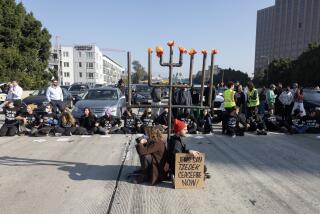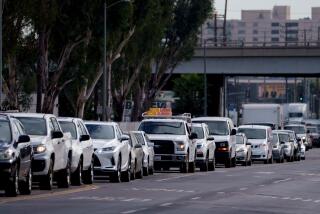‘The Lincoln Highway’ by Michael Wallis and Michael S. Williamson
THE road trip is an essential American experience that has inspired books, movies and television programs, including “The Grapes of Wrath,” “Route 66” and “Thelma & Louise.” More than a decade before the building of the Mother Road — Route 66, which connected Chicago and Santa Monica in 1926 — the audacious dream of crossing the entire continent on blacktop was given a certain reality in the designation of the Lincoln Highway, a route that exists today along some of those back roads that William Least Heat-Moon describes in a classic of road-trip literature, “Blue Highways.”
The Lincoln Highway is documented and celebrated with savvy and a strong dollop of sentiment in a new book by Michael Wallis, author of the best-selling “Route 66,” and Pulitzer Prize-winning photographer Michael S. Williamson. The authors conduct an illustrated tour across the years and miles through 13 states, stopping along the original route of the Lincoln Highway “from Times Square to the Golden Gate” to show us the sights and to reflect on how much (and, now and then, how little) things have changed in America.
The idea of the Lincoln Highway was conceived by Carl G. Fisher, founder of the Indianapolis Motor Speedway, and it won the calculating support of the infant automobile industry. The president of the Packard Motor Car Co. proposed to name the road after Abraham Lincoln, thus alloying patriotic sentiment with the profit motive. The project was formally announced in 1913, when the automobile was still a rarity in America, and began to fade as early as 1925, when a new federal highway system was proposed. “[B]y the onset of the Great Depression,” the authors write, “the highway was referred to in the past tense in New York.”
To be sure, the Lincoln Highway existed mostly in the minds of its planners. It was never an unbroken ribbon of highway; rather, it was merely a designated route that consisted of “more than 3,300 miles of macadam, pavement, and even a few dirt roads.” More often than not, the planners merely relabeled existing roads, and that’s how, for example, the crushed-stone Lancaster Turnpike in Pennsylvania, completed in 1795, came to be co-opted into the Lincoln Highway in the early 20th century. The whole project was mostly a matter of colored lines on a map and road markers on the ground, which is why the official guidebooks published by the Lincoln Highway Assn. warned the reader against “misleading signs” that were posted by local interests seeking to divert tourist traffic off the official route.
The book is lavishly decorated with photographs, both contemporary and historical, and various items of incunabula that conjure an earlier era and a very different state of mind than our own. A restaurant advertising card offers a 50-cent “hangover breakfast” of tomato juice, two raw eggs, dry toast, black coffee, aspirin “and our sympathy.” A hand-painted road sign in Ohio points in various directions — “Van Wert (92), Galion (4), Bucyrus (10), Tiro (10)” — including straight up: “Heaven.”
True to the spirit of wanderlust, the authors often stray from their own stated theme. For example, they recall the duel between Aaron Burr and Alexander Hamilton and describe a 2004 ceremony to commemorate the 200th anniversary of the event, when descendants of the famous men — “Douglas Hamilton, an IBM salesman from Ohio, and Antonio Burr, a New York psychologist” — reenacted the shootout, save for the live ammunition.
Why the incident belongs in a book on the Lincoln Highway is not explained, but the authors are unapologetic; indeed, they take us wherever their minds wander and they show us whatever sights catch their eye.
The insistent theme of the book is the unlikely survival of things past and the transforming power of time. Thus, for example, the night-lighted facade of Loew’s Jersey Theatre in the 1930s, where the marquee announces a screening of “Mr. Robinson Crusoe” starring Douglas Fairbanks and a live appearance by Russ Columbo and His Band, has all the grandeur of a cathedral.
But we are also shown the same building in more recent times, faded and down at heel, with the marquee now carrying a different message: “Farmers Market at JSQ Is Back!”
Still, the authors encourage us to regard a journey on the Lincoln Highway as something more than an exercise in nostalgia. Rather, they hold it out as “the quintessential road trip for all those willing to steer clear of the banal and humdrum.” At the same time, they warn us that it is “a route for travelers, not for tourists,” often lacking the gas stations and fast-food restaurants that line the ruler-straight routes of the interstate highway system. Just finding the roads that constituted the Lincoln Highway, in fact, can be challenging.
“While not concerned about going astray, travelers still scrutinize vintage Lincoln Highway maps and newer guidebooks,” they write about the stretch that runs through New Jersey. “Now the scavenger hunt really starts. All eyes scan the streets and neighborhoods for landmarks, bizarre signs, historic sites, and examples of commercial archaeology scattered among the ever-changing cityscape.”
The authors invoke William Blake as their muse: “Improvement makes straight roads,” wrote the visionary poet, “but the crooked roads without improvement are roads of genius.” It’s an apt credo — a certain mad genius was at work in the making of the Lincoln Highway, and the same can be said of inspiring the authors and, for that matter, anyone who follows their advice and goes in search of its haunting remnants.
--
Jonathan Kirsch is the author of, most recently, “A History of the End of the World: How the Most Controversial Book in the Bible Changed the Course of Western Civilization.”






